NVIDIA's GeForce GTX 465: Cheaper Isn’t Always Better
by Ryan Smith on May 31, 2010 3:26 AM ESTPower, Temperature, & Noise
In our GTX 480 review, we identified both the GTX 480 and GTX 470 as being abnormally hot & loud. Perhaps with the reduction in functional units and a lower memory clock speed NVIDIA will be able to bring this in to check? Let’s find out.
Or not.
Let’s first start with core voltage. For the GTX 400 series NVIDIA does not use a single voltage for each card, instead they assign voltage on a per-chip basis. So while there are trends we can look at, there is no absolute single voltage as we’ve seen on past cards. The following is the load voltage on each of our sample cards.
| GeForce GTX 400 Series Load Voltage | |||
| GTX 480 | GTX 470 | GTX 465 | |
| Load Voltage |
0.959v
|
0.962v | 1.025v |
In terms of core voltage the GTX 465 ends up being a notable outlier. Our GTX 480 and 470 samples have a load core voltage of 0.959v and 0.962v respectively according to GPU-Z, while our GTX 465 from Zotec is a good 0.04v higher at 1.025v. This is only a 4% increase in core voltage overall, but as GF100 has an idle voltage of .875v, this means it takes a 50% greater voltage increase over idle to bring our GTX 465 to load compared to our GTX 470.
NVIDIA is dealing with some very tight thermal and power requirements on the GTX 480 and 470 – getting a 3 billion transistor chip to not run amok drawing power is hard work. From this we can infer that NVIDIA is not only holding back chips with damaged functional units, but also chips that run but just take too much voltage (and ultimately power) to do so. With fewer functional units, the GTX 465 has a greater tolerance for high-voltage chips and it looks like this is where NVIDIA is sending some of them as a result. This is why there’s only a 15W TDP difference between the two cards: NVIDIA “spent” their savings getting lesser GF100 GPUs in to products. So going by voltage alone, it’s clear that we’re not going to see the GTX 465 receive a huge benefit in terms of power, temperature, & noise.

Moving on to our charts, we’ll start with idle temperatures. Even with the same idle voltage and same cooler as the GTX 470, the GTX 465 delivers a slight surprise: it ends up idling at 2C under the GTX 470. This puts it squarely in the same territory as the GTX 200 series.
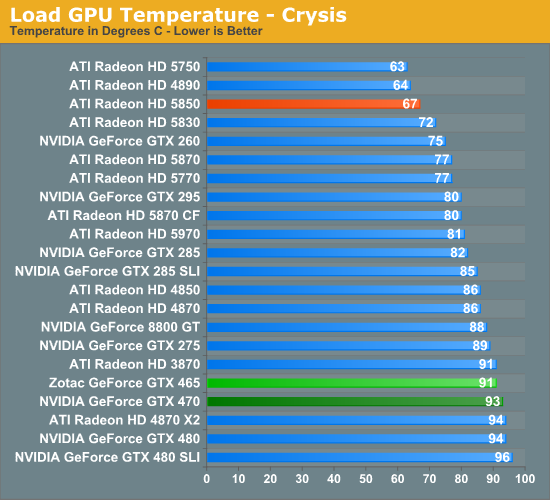
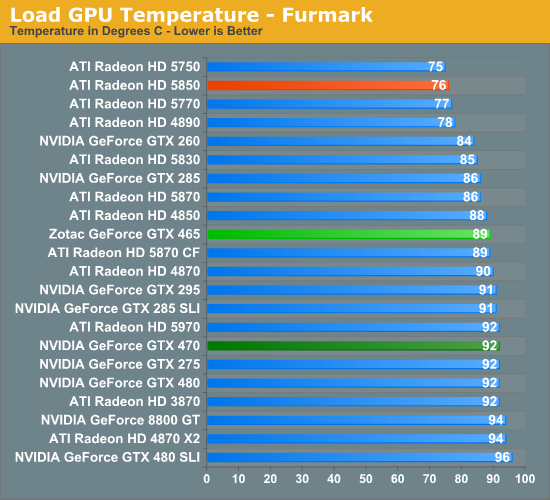
Moving on to load temperatures, we can begin to see the price of using a GPU with a higher core voltage. Under Crysis that 2C advantage over the GTX 470 holds, with temperatures peaking at just 91C. This still makes it the 3rd hottest single-GPU card we have tested, tieing with the Radeon HD 3870 and coming in 24C hotter than the 5850, a card it underperforms in this game.
FurMark has a similar showing, with the GTX 465 coming in 3C cooler than the GTX 470. Overall things are better for the GTX 465 here though, as it’s better than roughly half of our cards here, placing amongst the Radeon HD 4890, 4850, and only a hair above the 5870 and GTX 285. Even the gap between the GTX 465 and 5850 drops quite a bit, with only 13C separating the two.
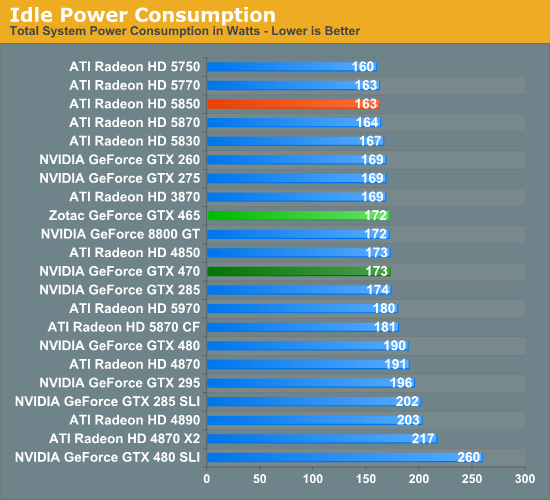
Next we have idle power consumption, measuring the total power consumption of our GPU testbench. While NVIDIA didn’t give the GTX 465 an official idle power draw, we’re measuring it at 1W less than the GTX 470. The GTX 470 was rated for 33W, so it’s safe to say the GTX 465 is close to that. It’s quite likely that the difference comes down to the savings from running 2 fewer GDDR5 RAM chips.
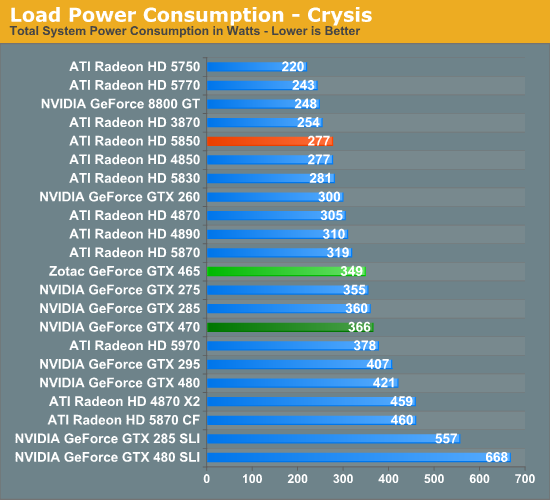
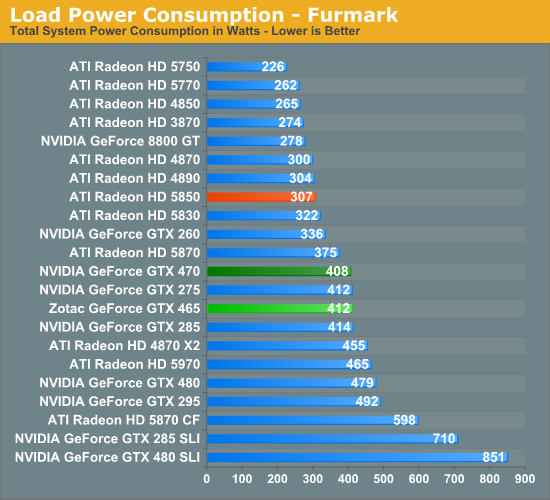
As for load power draw, having seen our temperature results the actual power figures should not be a surprise. Under Crysis the GTX 465 has more in common with the GTX 470 than the power-saving Radeon HD 5000 series, drawing 17W less than the GTX 470 and 72W more than the 5850. Based on our voltage numbers from earlier and this data, it’s clear that NVIDIA had to give up a lot of power savings to make this specific GPU operate.
Meanwhile under FurMark we see those savings evaporate in to nothingness. Here the GTX 465 actually surpasses the GTX 470 by 4W, coming in at 412W versus 408W. At this point it’s drawing as much power as a GTX 275/285, and 105W more than the Radeon 5850. We did not expect the GTX 465 to end up drawing more power than the GTX 470 here, as the 2 fewer RAM chips should have offset the difference. Looking at just the GPU, there’s a good chance the GPU in our GTX 465 card is drawing more power than the GTX 470 under most situations.
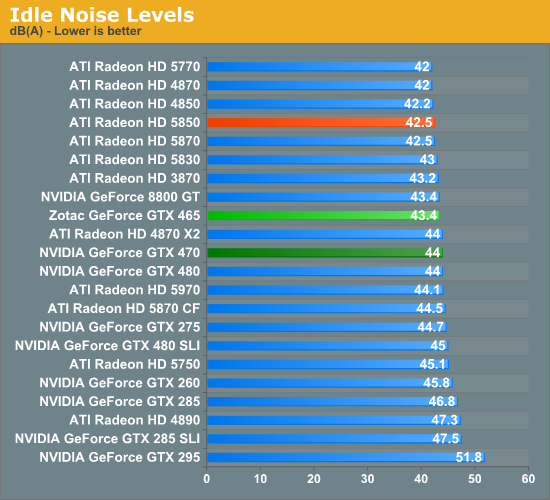
Last but not least we have our noise testing. As the GTX 465 uses the same cooler as the GTX 470, the results should be very close and our idle noise measurements deliver on that. Our GTX 465 idles at 43.4db(A), effectively tied with the GTX 470 and only marginally different than most of the rest of our cards.
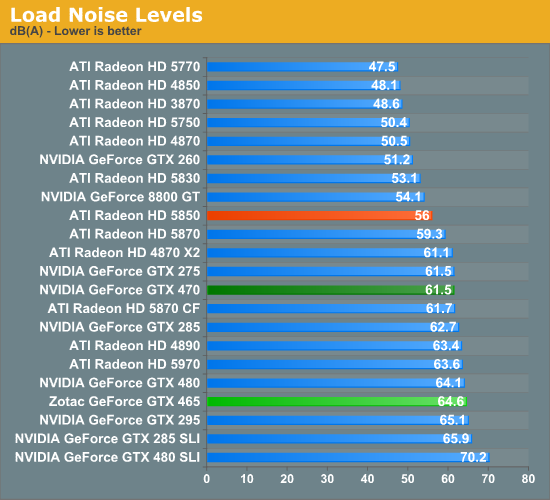
When we first did our load noise testing on our GTX 465, we thought something was wrong. It sounded louder than the GTX 480 or GTX 470, and when we put a sound meter to it the results reflected that. But after triple-checking our results there’s nothing wrong with our data – the GTX 465 really is louder than the GTX 470 and the GTX 480. As fan speeds are tied to the GPU temperature we’re looking at the culprit being the fan profile used for the GTX 465, as the hardware is identical to the GTX 470. It looks like NVIDIA tweaked the GTX 465 to be a bit more aggressive than the GTX 470, which in turn makes this the likely reason why we’ve measured the GTX 465 as being cooler than the GTX 470 in spite of their similar power draw.
Our best guess here is that with the GTX 465’s higher operating voltage, NVIDIA wanted a slightly lower operating temperature to compensate. As with any other case where we’ve only measured a single card there’s the possibility of a great deal of variation, but what we’ve seen makes sense. Across the entire spectrum of GTX 465 and GTX 470 cards it’s reasonable to assume this data is correct and that the GTX 465 is on average a couple of db(A) louder than the GTX 470.
It goes without saying that this isn’t a reasonable amount of noise for the performance the card delivers. The Radeon HD 5870 is 5dB(A) quieter, and the 5850 extends than to 8dB(A) quieter. At these noise levels 8dB(A) is a very noticeable difference.










71 Comments
View All Comments
poohbear - Monday, May 31, 2010 - link
Why's the 5770 10fps slower than the 4870? is that a mistake? they perform on par especially w/ the recent driver updates for the 5770.poohbear - Monday, May 31, 2010 - link
in mass effect 2.:p hate the no edit feature!Ryan Smith - Monday, May 31, 2010 - link
There aren't any typos; those are the results we got for those cards on the 10.3a drivers.temps - Monday, May 31, 2010 - link
I can vouch for that. When my 1gb 4870 died, it was replaced with a 5770. In ME2, I saw a 10-15fps drop across the board with the same settings.. that didn't do it for me, so I ended up stepping up to a 5850.BoFox - Tuesday, June 1, 2010 - link
Didn't you know that the 5770 is generally slower than 4870? The 4870 has far, far greater memory bandwidth despite a 100MHz lower core clock.tno - Monday, May 31, 2010 - link
I think a repost to the feed is appropriate when someone goes through this again and polishes it up. I couldn't finish the second paragraph it was so full or mistakes. Really guys there is no shame in hiring a copy editor.softdrinkviking - Tuesday, June 1, 2010 - link
i don't care about typos in this kind of article.aside from problems with the numbers, i think everyone knows what is meant.
i feel like it's expected that tech blog sites are littered with typos.
actually, i'd like to hear about this from ryan smith or somebody here.
do you guys want us to post typo corrections in the comments?
i don't care, but what does anandtech want?
taltamir - Monday, May 31, 2010 - link
According to the graph, the GTX465 gets 89 C not 91 C.
taltamir - Monday, May 31, 2010 - link
nevermind, I see now that there are two graphs, one for furmark and one for crysis.multivac - Monday, May 31, 2010 - link
NVIDIA filled in the first 2 spots in their lineup with the GTX 480 and GTX 480, with obvious room to grow out the family in the future.end of the first paragraph.
still reading but im sure its a great article
cheers!